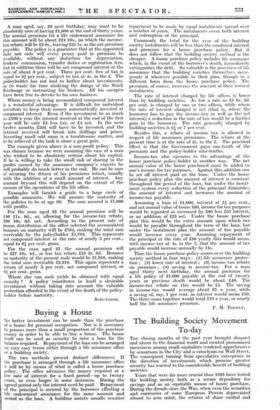Buying a House
No better investment can be made than the purchase of a house for personal occupation. Nor is it necessary to possess more than a small proportion of the purchase money in order to be able to buy a house. The 'house itself can be used as security to raise a loan for the balance required. Repayment of the loan can be arranged on very easy terms either through a life assurance office or a building society.
The two methods present distinct differences. If the purchase is arranged through a life assurance office it will be by means of what is called a house purchase policy. The office advances the money required at a low- rate of interest for a fixed period—up to twenty years, or even longer in some instances. During the agreed period only the interest need be paid. Repayment of the principal is secured by the borrower effecting a life endowment - assurance for the- mite - amount and period as the loan, A building society usually reauires repayment to be made by equal instalments spread over a number of years. The instalments .cover. both interest and redemption of the principal.
Commonly the total for the year of the building society instalments will be less than the combined interest and premium for a house purchase policy. But it does not follow that the building society method is the cheaper. A house purchase policy includes life assurance which, in the event of the borrower's death, immediately extinguishes the debt. So valuable is the provision of life assurance that the building societies themselves incor- porate it wherever possible in their plan, though in a different form from the house purchase policy. The premium, of course, increases the amount of their normal instalments.
The rate of interest charged by life offices is lower than by building societies. As low a rate as £5 Os. 8d. per cent. is charged by one or two offices, while _where the rate of interest charged is net (that is, where the borrower has, to pay the income-tax as well as the net interest) a reduction in the rate of tax would be a further gain to the borrower. The rate generally charged by building societies is 6i or 7 per cent.
Besides this, a rebate of income tax is allowed in respect of life assurance premiums. The rebate at the present time is at the rate of 2s. in the E. The practical effect is that the Government pays one-tenth of, the premium and the policy-holder nine-tenths.
Income-tax also operates to the advantage of, the house purchase policy-holder in another way. The net annual value of the house purchased must be added to one's income for tax purposes. Against this addition can be set off interest paid on the loan. Under the house purchase policy plan the amount of interest is constant throughout the period of the loan, but under the instal- ment system every reduction of the principal diminishes the amount of interest and increases the amount of income-tax payable.
Assuming a loan of £1,000, interest at 51 per cent., and net annual value of house £80, income for tax purposes would be regarded as increased by £80 less £55 interest, or an addition of £25 net. Under the house purchase plan this would be the extra amount upon which tax would be payable throughout the term of the loan, but under the instalment plan the amount of tax payable would increase every year. Assuming repayment of the principal at the rate of £50 yearly this would mean, with income-tax at 4s. in the £, that the amount of tax payable would increase annually by lls.
Thus the house purchase policy scores over the building society method in four ways : (1) life assurance protec- tion ; (2) lower rate of interest ; (3) income-tax rebate on premium ; (4) saving in income-tax. For a man aged thirty next birthday, the annual premium for a life policy of £1,000 payable at the end of twenty years or previous death would be about £40. The income-tax rebate on this would be £4. The saving in income-tax would average about £5 a year, while a saving of, say, 1 per cent. in interest would mean £10. The three sums together would total £19 a year, or nearly half the life assurance premium.
F. M. TOOVEY.,
























































 Previous page
Previous page